Children love water play. I have always loved the work of Tom “Sensori” Bedard who writes the blog Sand and Water Tables. It’s very niche and all about engaging children through well-thought out apparatus and creations at the sand and water trays.
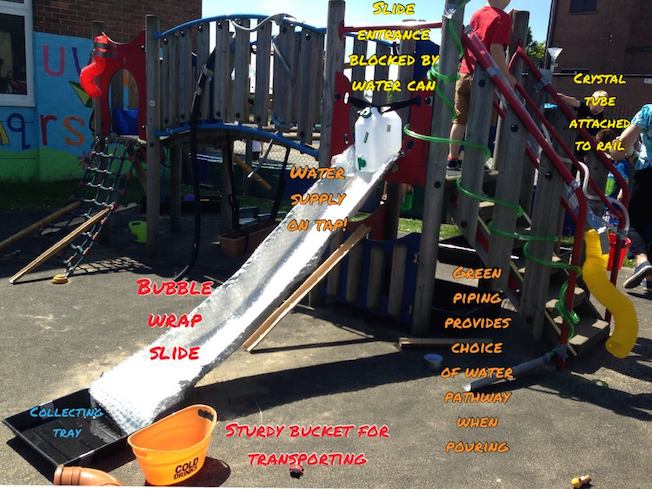
Tom developed a simple system for setting up play-based learning experiences. He spent hours observing and recording children play. However it is all indoors. I work almost entirely outdoors. We both have always believed his principles and advice can be applied to an outdoor context as this post illustrates.
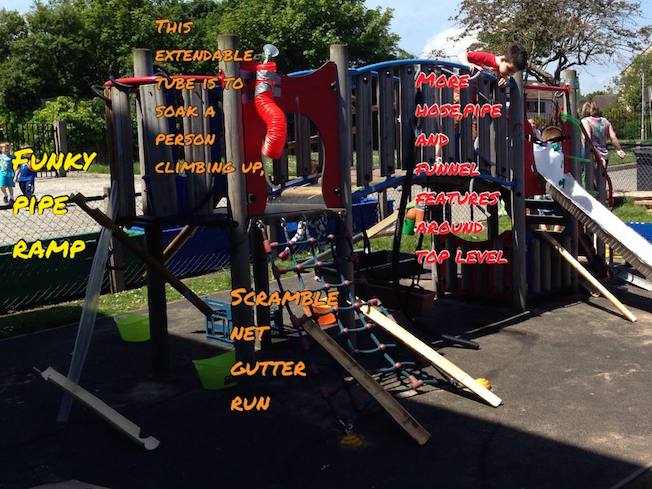
Years ago I’d been working with a local nursery on a series of outdoor experiences. We had already decided that this week’s session was going to be looking at ways of developing water play. I thought this was an ideal opportunity to try out some of Tom’s suggestions and to see what happened.
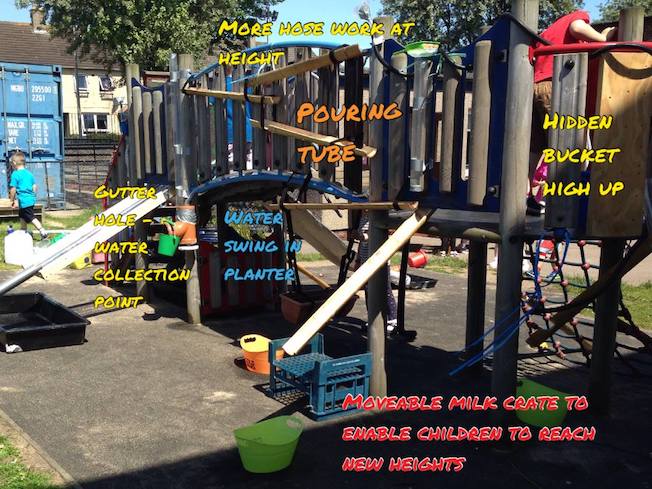
You can view Tom’s exact advice on the RH column of his blog. One of his first points is that we need to think vertically and horizontally. By tradition, water walls are vertical surfaces and water trays are horizontal surfaces. However on a piece of play equipment you have the potential to organise both!.
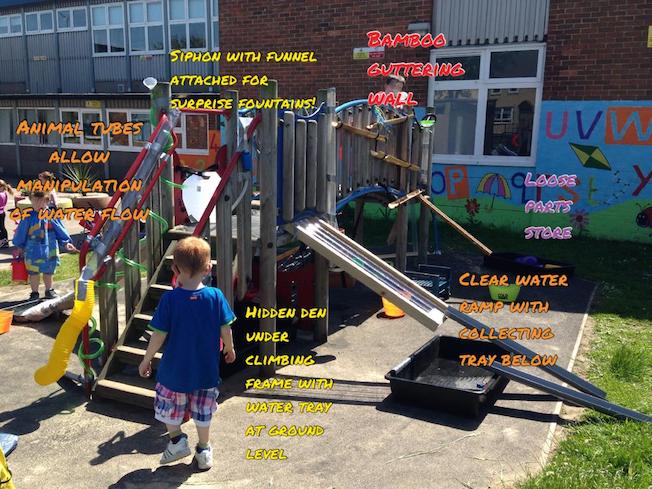
Tom also discusses the value of levels. Again, the play frame automatically provides these elements. We kept the steps and raised platform free from equipment other than a bucket of water at the end. This meant that children only had to negotiate each other and not objects whilst up high. We also kept the hand rails free from attachments as much as possible too so that children were able to use these and other built-in safety features. The walking surface of the play structure was grippy and the children were used to using it in rain as well as sunshine.
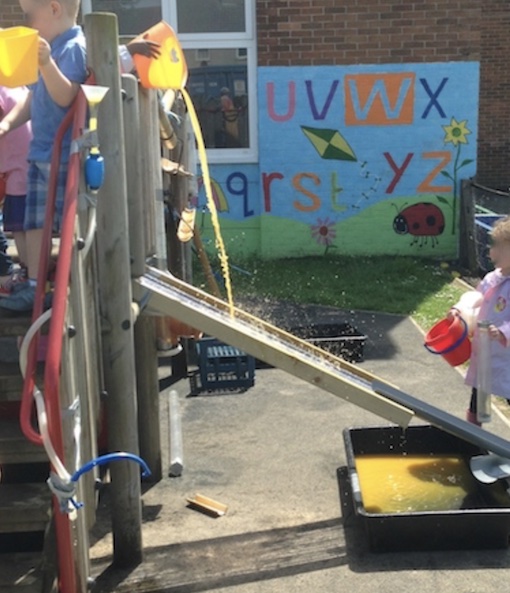
Tom also flags up the value of inclines – or slopes. These can be gentle or steep. A play frame also provides plenty of opportunities to create inclines of different sorts. In the photo above, you can see the magnificent water ramp protruding out. This stayed in place quite naturally but we added a little duck tape to provide additional security.
Tom also talks about the need for a pail or bucket so that children can transport water from a tray to the pail and vice versa. On such a large scale, we made do with the black water trays which were great even if they were more about breadth than depth, it enabled lots of children to access them – perhaps I should refer to these as “horizontal pails.” I deliberately put ones at places where I anticipated children would like to pour water – such as down inclines!

Bamboo guttering also provided inclines. We created the traditional water wall in one area with guttering but the climbing frame enabled this to capitalise on horizontal flow too – by sticking out of the climbing frame. The crystal tubes allowed children to observe coloured water flowing in all directions. Anything that was protruding from the play structure was clearly visible and with no sharp corners. As much as we could we tried to build in safety into what we were adding without it stopping the enjoyment of experimenting.
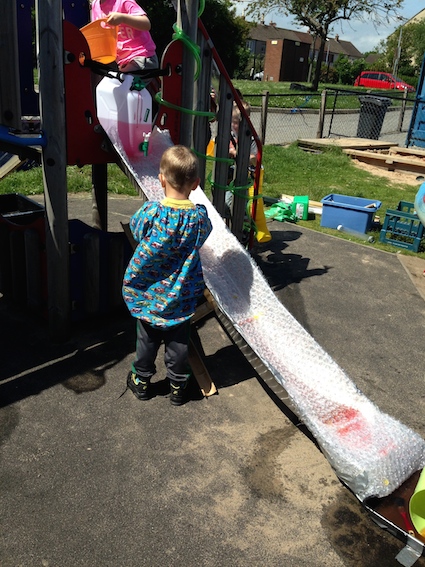
Tom had mentioned about how water flows differently when travelling down bubble wrap. By chance I happened to have a perfect slide-sized piece. This was duck-taped down. I put the jerry can at the top and secured this with super-strong velcro. This amazing stuff kept the can upright and accessible by the children who learned quickly how to turn the tap on and off. Interestingly as the afternoon wore on, the children began to ignore the can and preferred transporting water up the steps and tipping it directly down the slide from above.
Some children chose to pop some of the bubble wrap. This turned into a fascinating experience because these bubbles then filled with water and could be pressed to release it after each water flow had passed by. I had wondered whether the children would get frustrated at not being able to slide down the slide but this was not an issue. I think there was too many other things happening!
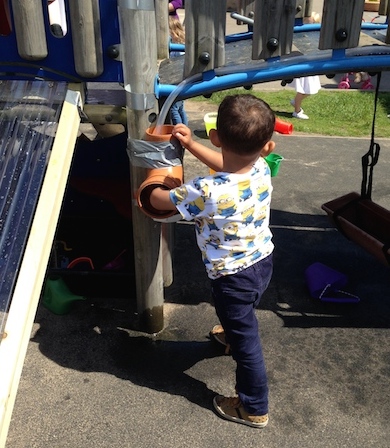
Holes matter to children. They will spend hours exploring holes. The play frame had lots of holes in it but we added some interesting ones using the bits of guttering. Look how the child in the above photo is able to put his hand right inside. We had a few Duplo figures which were also part of the play for some children.
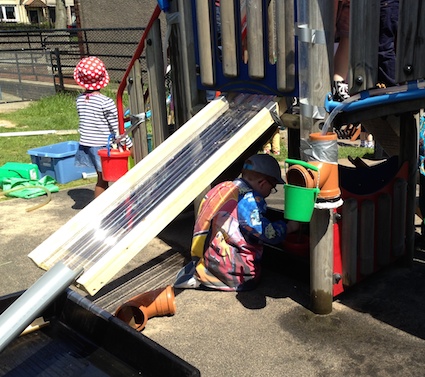
Underneath the water ramp you can see a little cubby hole! This allowed for a quieter play area. We could see in and check that the children were okay without them feeling they were being watched. Lots of children visited this area during the course of the afternoon. This was managed by the availability of space in that only one or two children could fit in there at any one time. Tom alludes to the need for creating spaces within places and apparatus.
In line with Tom’s guidance, we also placed a variety of loose parts in two areas, one at either end of the climbing frame. This meant that children could add to the play in ways they wanted to. The carrying buckets (from Poundland) were most popular. They were smaller than your 5 litre pail but bigger than your average sand castle bucket.
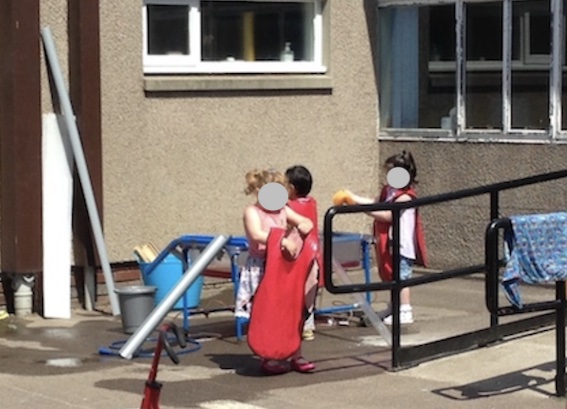
Now, we also had more than one water station! Oh yes! There was a traditional water tray across the space which allowed for a group of children less interested in the hubbub of the climbing frame to get on and experiment.
There was also a water container placed beside another “remote” water station so that children could fill up and transport water to the climbing frame. This water station was an “up and over” water wall. You can see this to the right in the above photo. Tom talked about children needing to experience reaching high. In order to do this, the children used their initiative and helped themselves to a bread crate. Some even went up on the wall itself. It didn’t seem to matter to any child that they could not see the water once it had been poured down the funnel. The act of getting up and tipping out the water seemed to be the point of the activity.
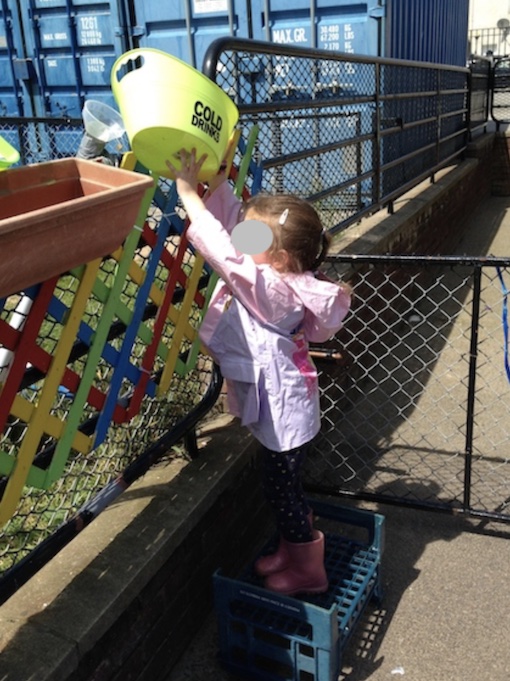
The children enjoyed being able to help themselves to water. As Tom had said, the amount of water flying around was surprisingly little. The children want and chose to transport water between places purposefully. They also enjoyed helping each other out.
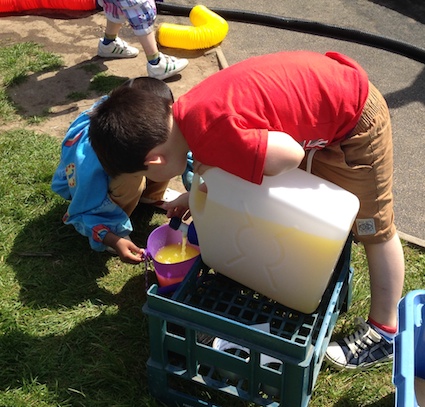
We witnessed a high degree of social interaction between the children. We did not limit numbers of children at any place – the children self-regulated this without adult input and largely through common sense.
Many thanks to Tom for all his advice and suggestions, The ensuing play was a pleasure to witness and has further inspired me to explore creatively his elements and axioms.
In case you are wondering, almost all the equipment you can see comes from the Cosy Catalogue. They stock lots of good open-ended resources which facilitates this type of water play.
There were lots of features for the children to explore. The apparatus was set up in advance of the afternoon session, thanks to the willingness of the nursery staff to enter into the spirit of the adventure!
This post was originally published in June 2014.




















Love the way this gigantic water play is set up. Looks like so much fun for the kids.
Yes it is! i just loved the deep play which arose in the couple of hours children were able to access this area. Thanks for commenting.
This looks fantastic! Such a clever way to take water play to the next level and really allow them to explore so many different things. I love this post! The bubble wrap down the slide is brilliant, and I thought that may frustrate the children but it is nice to see that it didn’t! Great stuff and I look forward to experimenting with this at home with my little one, although maybe on a slightly smaller scale!! 🙂 xx #countrykids
Hi Caroline,
I think this is one of my favourite posts this year. Tom’s principles really do work – I’m hoping to get to try a smaller scale version with my neighbour and her child.
Thanks for your thoughts.
It is really exciting and interesting to see your philosophy/ideas and Tom’s philosophy/ideas “collide.” This looks like so much fun! And I can see lots of play and experimenting happening in this environment. Thanks Juliet!
Agreed! I think Tom’s suggestions were waiting to be let out of the box!
Juliet, I can just imagine all the fun you had setting this up. I have never thought to use a climbing structure to set up so many different apparatus. It is a natural because of all the holes, levels and spaces with all the different orientations. As they say in the UK: It is absolutely brilliant. Thanks for all the shout-out. One of the most interesting parts of my trip is to see how practitioners interpret and use the axioms and dimensions. No two are alike and some really run with it like you. Again, thanks for hosting me up in Aberdeen.
Tom – You’re welcome! The trail of positive feedback following your presentations is great to hear.
This is fabulous!! Little Man would have loved to play like this and I would have loved to watch it. I might have to pass this onto his nursery xx